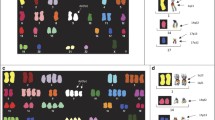Abstract
Cytogenetic analysis of earlyin vitro cultures derived from human melanomas, two primary tumors (Me 10538, Me 1402) and two metastatic lesions in the same patient (Me 665/1, Me 665/2) showed non-random involvement of C-heterochromatin in clonal chromosome rearrangements. Marker chromosomes with C- and DA-Dapi-positive bands were identified in one of the metastases, Me 665/1 (ml) and in the two primary tumors, Me 10538 (m2) and Me 1402 (m3). C-positive fragments predominated in the other metastasis, Me 665/2, which lacked C-regions intercalated in rearranged chromosomes, and were also detected with appreciable frequency in the Me 665/1 and Me 1402 cells. The frequencies of marker chromosomes and their mean number per cell allowed m2 and ml to be considered as early markers of tumor formation and m3 as a marker of tumor progression. Dissection of chromosome structure, including the origin of the intercalated C-band, has so far been achieved only with the m2 chromosome of the primary tumor Mel0538. This was the only cell line which displayed few C-fragments and a narrow chromosomal distribution with a well defined mode. A gradient of malignancy could be detected in the four cell lines, by local and disseminated tumor growth in xenotransplanted mice, with the two primary melanomas 10538 and the 1402 cells at the lowest and upper extremes. This gradient closely parallels the increase in cytogenetic heterogeneity and C-heterochromatin lesions from the 10538 to the 1402 cells.
Similar content being viewed by others
References
Atkin, N. B., andBrito-Babapulle, V., 1981, Heterochromatin polymorphism and human cancer.Cancer Genetics and Cytogenetics,3, 261–272.
Atkin, N. B., andBrito-Babapulle, V., 1985, Chromosome 1 heterochromatin variants and cancer: a reassessment.Cancer Genetics and Cytogenetics,18, 325–331.
Atkin, N. B., andBaker, M. C., 1985, Chromosome analysis of three seminomas.Cancer Genetics and Cytogenetics,17, 315–323.
Brito-Babapulle, V., andAtkin, N. B., 1981, Breakpoints in chromosome #1 abnormalities of 218 human neoplasms.Cancer Genetics and Cytogenetics,4, 215–225.
Denton, T. E., Howell, W. M., andBarrett, J. V., 1976, Human nucleolar organizer chromosome: satellite associations.Chromosoma,55, 81–84.
Doneda, L., Di Renzo, M. F., Comoglio, P. M., andLarizza, L., 1985, Role of heterochromatin variation in the instability of a marker chromosome during tumor progression.Cancer Genetics and Cytogenetics,15, 283–291.
Doneda, L., Fuhrman Conti, A. M., Gualandri, V., andLarizza, L., 1987, Mosaicism in the C-banded region of chromosome 1 in cancer families.Cancer Genetics and Cytogenetics,27, 261–268.
Doneda, L., Ginelli, E., Agresti, A., andLarizza, L., 1989,In situ hybridization analysis of interstitial C-heterochromatin in marker chromosomes of two human melanomas.Cancer Research,49, 433–438.
Fossati, G., Balsari, A., Taramelli, D., Sensi, M., andPellegris, G., 1982, Lysis of autologous human melanoma cells byin vitro allosensitized peripheral blood lymphocytes.Cancer Immunology and Immunotherapy,14, 99–104.
Giavazzi, R., Campbell, D. E., Jessup, J. M., Cleary, K., andFidler, I. J., 1986, Metastatic behaviour of tumor cells isolated from primary and metastatic human colorectal carcinomas implanted into different sites in nude mice.Cancer Research,46, 1928–1933.
Haaf, T., andSchmid, M., 1988, Analysis of double minutes and double minute-like chromatin in human and murine tumor cells using antikinetechore antibodies.Cancer Genetics and Cytogenetics,30, 73–82.
Kovacs, G., 1978, Abnormalities of chromosome 1 in human solid malignant tumors.International Journal of Cancer,21, 688–694.
Larizza, L., Doneda, L., Ginelli, E., andFossati, G., 1988, C-heterochromatin variation and transposition in tumor progression.Cancer Metastasis: Biological and Biochemical Mechanisms and Clinical Aspects, edited by G. Prodi, L. A. Liotta, P.-L. Lollini, S. Garbisa, S. Gorini and K. Hellmann (New York: Plenum Press), pp. 309–318.
Morris, C. M., Fitzgerald, P. H., Neville, M. A., Wyld, P. J., andBeard, M. E. J., 1984, Does multisomy of chromosome 1q confer a proliferative advantage in B-cell acute lymphoblastic leukemia?Cancer,54, 48–53.
Ohyashiki, J. H., Ohyashiki, K., Gibas, Z., Karakousis, C., andSandberg, A. A., 1986, Cytogenetic findings in a malignant melanoma and its derived cell line.Cancer Genetics and Cytogenetics,23, 77–85.
Pedersen, M. I., Bennett, J. W., andWang, N., 1986, Nonrandom chromosome structural aberrations and oncogene loci in human malignant melanoma.Cancer Genetics and Cytogenetics,20, 11–27.
Petkovic, I., Nakic, M., Tiefenbacg, A., Konja, J., Kastelan, M., Rajic, L., andFeminic-Kes, R., 1987, Marker chromosome lq+ in acute lymphocytic leukemia.Cancer Genetics and Cytogenetics,24, 251–255.
Raimondi, S. C., Ragsdale, S. T., Behm, F., Rivera, G., andWilliams, D. L., 1987, Multiple telomeric associations of a trisomic whole q arm of chromosome 1 in a child with acute lymphoblastic leukemia.Cancer Genetics and Cytogenetics,24, 87–93.
Rodolfo, M., Balsari, A., Clemente, C., Parmiani, G., andFossati, G., 1988, Tumorigenicity and dissemination of primary and metastatic human melanomas implanted into different sites in athymic nude mice.Invasion and Metastasis,8, 317–331.
Rowley, J. D., 1977, Mapping of human chromosomal regions related to neoplasia: evidence from chromosomes 1 and 17.Proceedings of the National Academy of Sciences of the USA,74, 5729–5733.
Schweizer, D., Ambros, P., andAndrle, M., 1978, Modification of Dapi banding on human chromosomes by prestaining with a DNA-binding oligopeptide antibiotic, distamycin A.Experimental Cell Research,111, 327–332.
Sumner, A. T., 1972, A simple technique for demonstrating centromeric heterochromatin.Experimental Cell Research,75, 304–306.
Verma, R. S., Macera, M. J., andBabu, A., 1988, The role of heterochromatin in the origin of isochromosome 1 in neoplastic cells.European Journal of Cancer and Clinical Oncology,24, 821–823.
Wolman, S., 1983, Karyotypic progression in human tumors.Cancer Metastasis Reviews,2, 257–293.
Author information
Authors and Affiliations
Rights and permissions
About this article
Cite this article
Larizza, L., Doneda, L., Rodolfo, M. et al. High incidence of chromosomal lesions involving C-heterochromatin in four human melanoma lines. Clin Exp Metast 7, 633–644 (1989). https://doi.org/10.1007/BF01753674
Received:
Accepted:
Issue Date:
DOI: https://doi.org/10.1007/BF01753674




